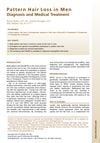A Multicenter Cohort Study of the Clinicopathological Features and Treatment Outcomes of Fibrosing Alopecia in a Pattern Distribution
October 2025
in “
Clinical and Experimental Dermatology
”
TLDR Fibrosing alopecia can be stabilized or improved with anti-inflammatory treatments and hair growth agents.
This multicentre cohort study investigated the clinicopathological features and treatment outcomes of fibrosing alopecia in a pattern distribution (FAPD) across nine dermatology centers, involving 110 patients, 85.5% of whom were female with a mean age of onset of 52.5 years. Key findings included the loss of follicular ostia and anisotrichia in over 96% of cases, with histopathology showing perifollicular lymphocytic infiltration and concentric lamellar fibrosis in similar proportions. After a median treatment duration of 36 months, hair stabilization was observed, with 15 out of 31 patients achieving stabilization and 14 showing improvement. The study highlights the potential for misdiagnosis with androgenetic alopecia and suggests that a combination of anti-inflammatory treatments and hair growth-promoting agents can stabilize or improve the condition. Limitations include its retrospective design and varied treatments.










